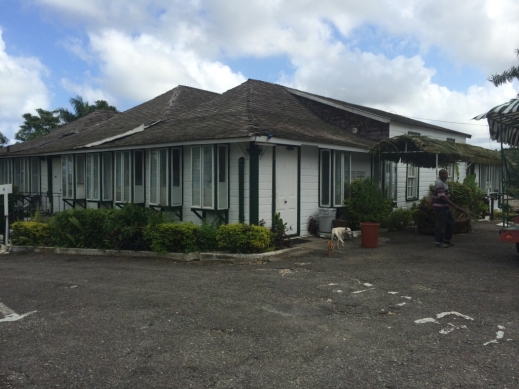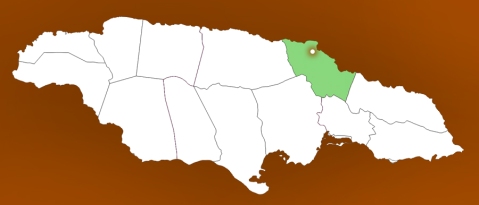Eaton Park Great House
Our Visit to the Eaton Park Great House
While the Fontabelle Great House sheltered a few of the world’s estimated 1 billion squatters, the Eaton Park Great House was yet another step removed from its glory days. The house is 5 kilometers south of the Oracabessa bus and taxi park on Jack’s River Road just before a bridge at the north edge of the hamlet of Eaton Park. Pass through the white painted concrete gate posts across the river, and the house is on the left.
The white Eaton Park Great House was probably the most “romantically decrepit” great house I had seen. Dry wood termites and wood rotting fungi have ravaged the structure over the years. Thick vines enveloped the barely-standing house as it continues to slip back into the earth from which it came. The roof, featuring a trio of gables in succession, give the house a unique architectural signature compared to other great houses. I could tell the existing house was not the original structure as it covered only part of the stone foundation. Further, large arches in the huge foundation suggested a much larger and heavier house once stood there.
I slipped into the house and took a few photos, being careful not to plunge through the rotten floor boards. Given the poor condition of the structure, the photos below could be among the last taken before the jungle reclaims the house for good.
From its perch atop a slight knoll, the remains of the house look down on a hardware store, which likely housed a collection of shops servicing the great house during colonial times. The shops, which once featured arched doorways, were constructed of stone and covered with old world ballast bricks. Someday, I hope to get more information on the Eaton Park Estate.
Eaton Park Group House Photo Gallery
Eaton Park Great House Location
Fontabelle Great House

The Rise of the Modern Banana Industry
The Fontabelle Great House, sits in the center of a former banana plantation. Until the late 1800s, the crown colony of Jamaica was wholly depended on sugar exports. The economic terrain was dramatically altered in 1870 when Captain Lorenzo Dow Baker, an American sailor, exported 160 bunches of bananas from Jamaica to New Jersey during an 11-day voyage. Baker’s enterprise, the first commercial transport of tropical bananas to temperate zones, became the Boston Fruit Company in 1885, the United Fruit Company in 1899, and Chiquita Brands International in 1990. By the close of the 19th Century, the Boston Fruit Company owned 35 Jamaican plantations covering more than 40,000 acres. Perhaps the banana plantation surrounding the Fontabelle Great House is part of the Boston Fruit Company story.
The Search for the Fontabelle Great House
I turned off the main road, into the Fontabelle neighborhood only to head up the wrong road. I stopped to ask a group of men the location of the great house, and a man named Patrick volunteered to lead me to the house. After turning around in the one lane road, we headed back down the hill to a lightly used track and then up another hill. The entrance to the property is marked by two yellow columns topped with white peaked pier caps. The columns are flanked by mature royal palm trees painted yellow up to the height of the columns. A winding dirt road led to a great house that appears only recently abandoned by its owners, perhaps within the last decade.
The two of us hiked up the hill, passing a swimming pool now serving as an overgrown tree pot. We climbed the steps to the front porch where we met an elderly woman who directed us to the other side of the house. We entered the Fontabelle through the kitchen into what must have been a beautiful house. Today, it has become a squatter apartment for several families. While these squatters were the poorest of the poor, their presence was not uncommon. In 2009, the Ministry of Water and Housing released findings of a study claiming that 20% of Jamaica’s population–nearly 600,000 today–are residential squatters. Combined with squatters in commercial and agricultural areas, the island has an estimated 1 million squatters, a reality that prompted the government to establish a Squatter Management Unit in 2006.
The fan lights perched atop the Fontabelle’s interior doors characterize the Jamaican Georgian architectural style which adapted the Georgian style to the Caribbean climate. In Britain, the fan lights would have included glass. In Jamaica, air flow was more important. Graffiti on one of the bedroom walls read, “O Lord, I need money.” Aside from old bed mattresses, hanging laundry, and a few cooking items in the kitchen, the house was relatively empty. We walked out on the front porch, hemmed in by a delicate (and rusting) banister. I could imagine the great view of the past, looking out over the lush acres of banana trees.
After touring the great house, Patrick took me down the hill to the edge of Jacks River. I visited the defunct water wheel in the mill and the attendant box plant where the owners boxed bananas. All wooden parts of the buildings have long since disappeared and just the stone walls and steel water wheel are left. Patrick would be glad to give you a tour for a modest fee. I hope to find out more about the Fontabelle great house as I study the history of Jamaica.
Fontabelle Great House Photo Gallery
Fontabelle Great House Location Map
Harmony Hall Great House

Our Visit to the Harmony Hall Great House
Our trip to Harmony Hall Great House, one of Jamaica’s most beautiful buildings, was well worth it, if for no other reason than for a meal at the world famous Toscanini’s Restaurant, which is located on the first floor of the house. I had an excellent Rabbit Ragu with Pappardelle Pasta along with excellent pumpkin soup. My wife, Bonita, enjoyed Spaghetti with Shrimp Versailles as well as one of the best cups of coffee in her life.
The Harmony Hall Great House was built in the late 1850s on a plantation growing pimentos and limes. The plantation later shifted to bananas in 1910 and coconuts in 1938. Eventually, the house became the manse of a Methodist church and the home of Sir Hugh Sherlock when he served on the Methodist Ocho Rios circuit from 1937 – 1940. In 1962, Sherlock wrote the lyrics of the National Anthem: Jamaica, Land We Love (see lyrics below). The house then was sold to the Lobban family who lived there for nearly fifty years. It was sold in 1980 to Annabella Proudlock and became the Harmony Hall Art Gallery in 1981 with the excellent restaurant on the first floor.
The house was built in the Jamaican-Georgian style. The pastel pink walls and green roof is highlighted by an intricate white fretwork of gingerbread and a white balustrade along the upper balcony. The octagonal cupola on the northeast corner with lattice and fretwork completed the delightful, almost fairy tale appearance of the building. The interior is painted bright white and is light and airy, to show off a collection of local artists and craftsmen. The original detached kitchen is still visible but is no longer used as a kitchen.
Contact Information for the Harmony Hall Great House
It is located 6 kilometers east of Ocho Rios on A3. It is open from 10:00 AM – 5:30 PM Tuesday through Sunday.
Telephone: 876-975-4222.
Website: www.HarmonyHall.com.
Email: info@harmonyhall.com
Jamaica National Anthem | Lyrics by Sir Hugh Sherlock
Eternal Father bless our land,
Guard us with Thy Mighty Hand,
Keep us free from evil powers,
Be our light through countless hours.
To our Leaders, Great Defender,
Grant true wisdom from above.
Justice, Truth be ours forever,
Jamaica, Land we love.
Jamaica, Jamaica, Jamaica land we love.
Teach us true respect for all,
Stir response to duty’s call,
Strengthen us the weak to cherish,
Give us vision lest we perish.
Knowledge send us Heavenly Father,
Grant true wisdom from above.
Justice, Truth be ours forever,
Jamaica, Land we love.
Jamaica, Jamaica, Jamaica land we love.
Harmony Hall Great House Photo Gallery
Harmony Hall Great House Location Map
Brimmer Hall Great House

Our Visit to the Brimmer Hall Great House
Today Bonita and I toured a great house worth visiting if you want to experience a working plantation. We left our house in Kingston at 8:45 AM and after an hour and a half drive on winding roads due north on Highway B3 and later A3, we arrived at the Brimmer Hall Great House. The road off A3 is a bit tricky to find as are most places in Jamaica. In the town of Trinity about 10 kilometers south of Port Maria, we turned east at the Epping gas station, bearing left at the junction in Bailey’s Vale. We followed the road and after crossing a rock and concrete ford, turned left through the main gates.
Zachary Bayley owned Brimmer Hall, Trinity, Tryall, and Roslyn. These 4 contiguous plantations comprised 4,000 – 5,000 acres. It was one of the most profitable plantations in Jamaica because of the richness of its soil, the closeness to a port, and ample rainfall. It employed approximately 1,100 slaves, housed in barracks scattered over the acreage. He built the great house in the 18th century. The first and main source of income was sugar, which reached 1,450 hogsheads (1 hogshead = 1,600 pounds) of sugar in 1815. This later would be supplemented with cocoa nuts and bananas. The property was later sold to Brimmer, Linder, Vaughn, and finally to Ernest Smatt, who owns it today.
The house is a single story building with glass louver windows and cooler boxes. The structure has high ceilings, polished wooden floors and a wide verandah. The Great House is furnished with original pieces and boasts an exceptional collection of antiques with polished fittings. The floors, ceilings and windows are constructed of native hardwood skillfully hand constructed. There is a master bedroom with a private study and three other bedrooms, a living room and a modern kitchen added. The out-buildings consist of storage sheds, household servant’s quarters, two kitchens (one for the great house and one for the servants), stables, and a bar where the owner would entertain his male friends. The groom was required to saddle horses for his master and mistress every morning in the event they wanted to ride. If they decided they didn’t need a horse, he was told and he could then remove the saddle and other riding gear.
Michael Lawton, who is the general manager of the estate, remembers his father working on the estate when Major Douglas John Vaughn owned the property. The help never approached the great house and as a boy, if he ever got near the house, his father would have been fired. All field hands met the overseer at the bottom of the hill. He remembers when the owner rode through Bailey’s Vale; the people would rise and salute him as he passed. Every year end, the Vaughn’s would kill a bull and throw a big feast for the community.
Contact Information
A trip to Brimmer Hall is well recommended and the contact information is 876-994-2309 or 876-974-2244. It is open for tours Monday-Friday 9:00 AM – 4:00 PM.



















































































Recent Comments